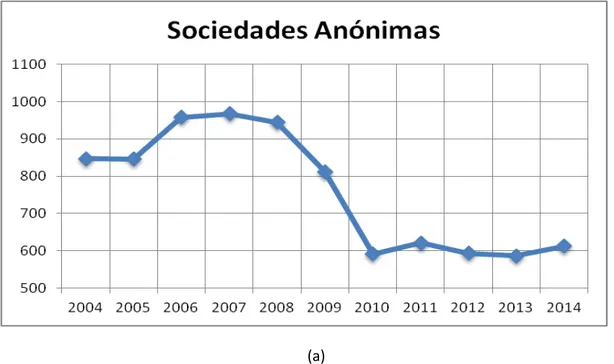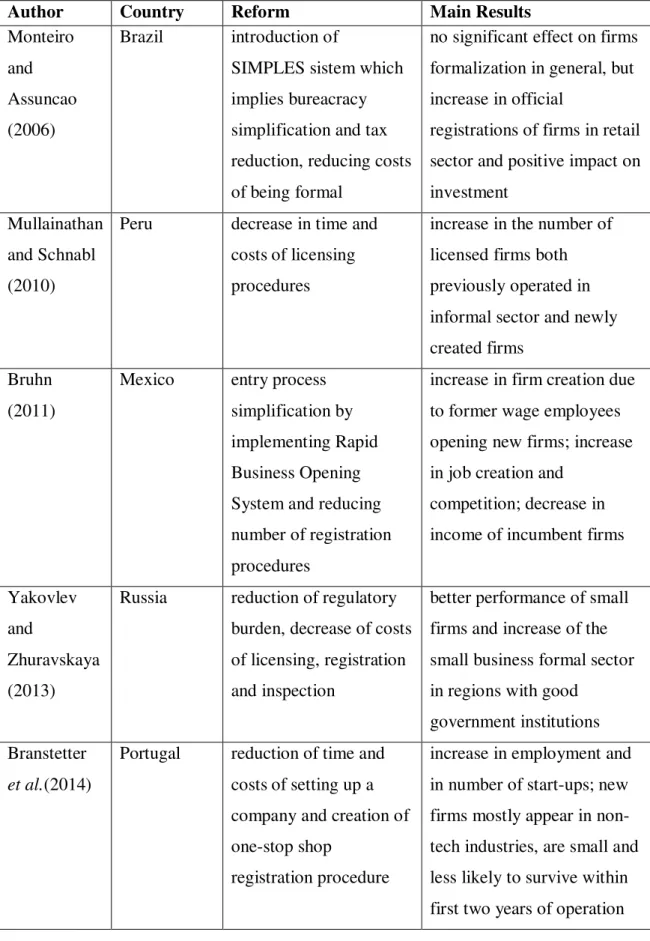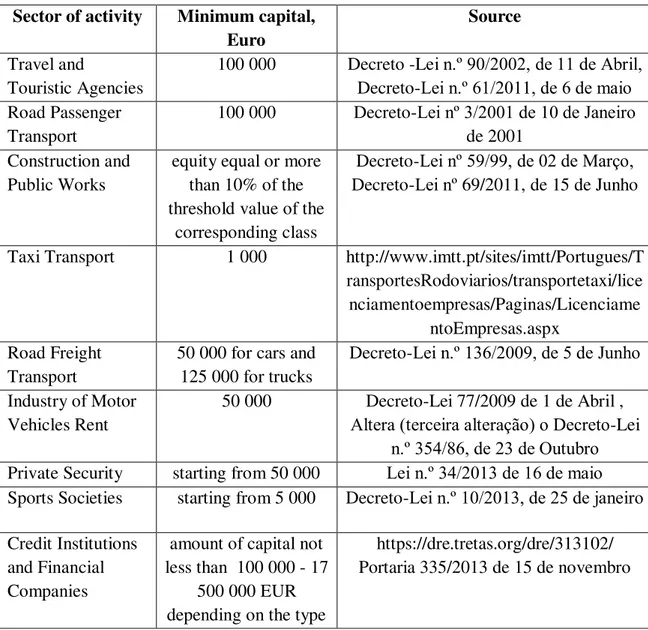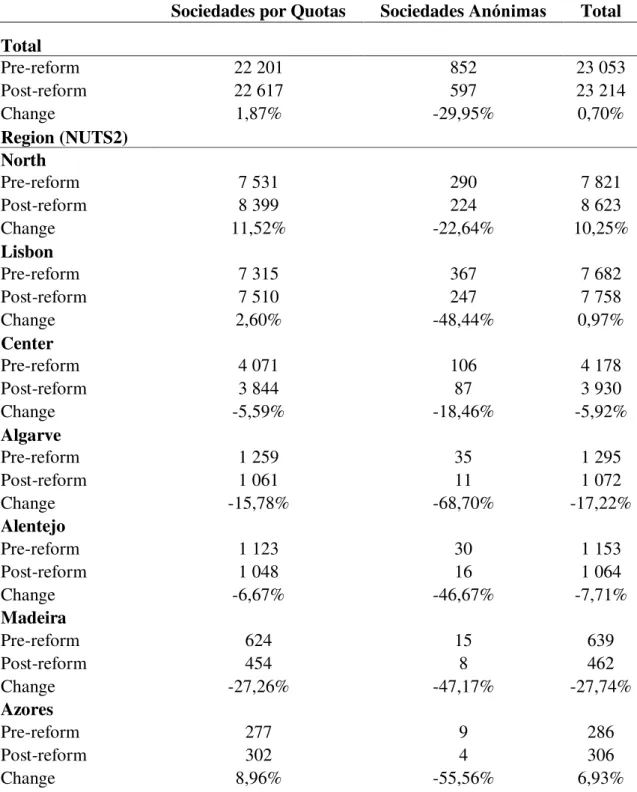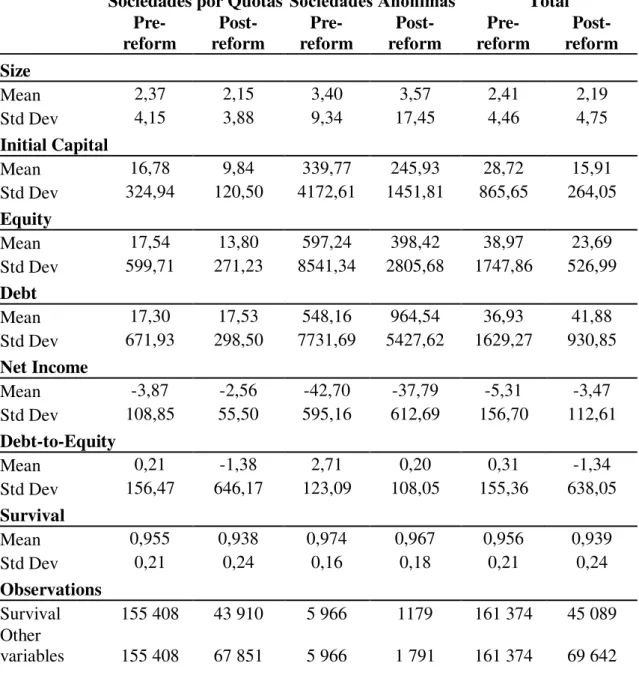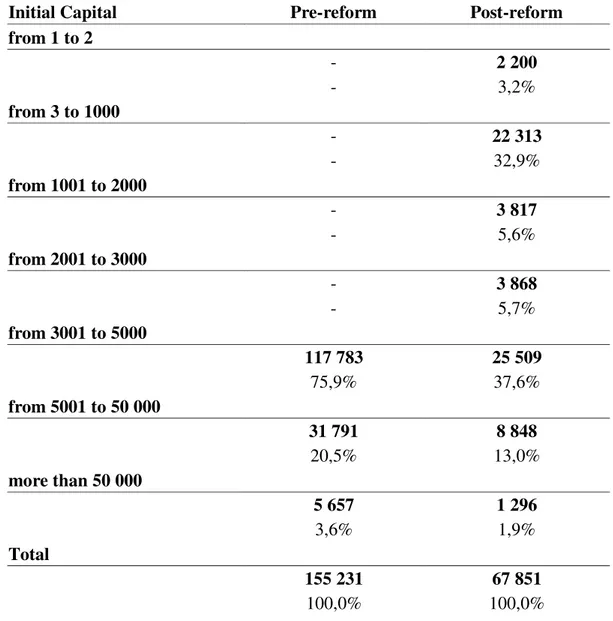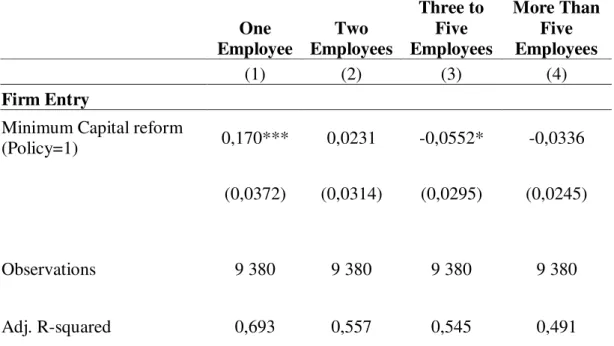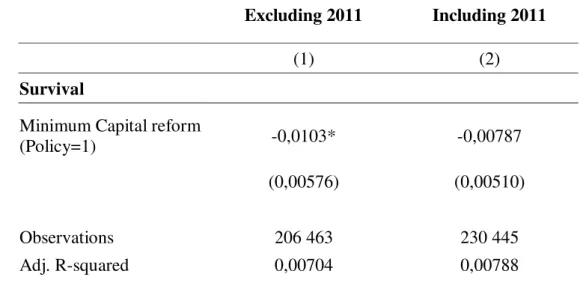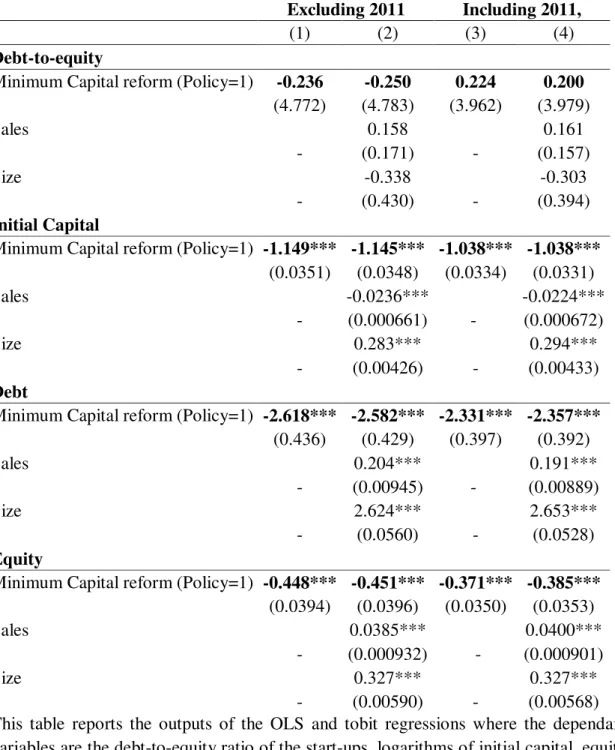OCTOBER 2016
M
ASTER IN
F
INANCE
M
ASTER
’
S
F
INAL
W
ORK
DISSERTATION
MINIMUM CAPITAL REQUIREMENT POLICY AND
ENTREPRENEURIAL ACTIVITY
OCTOBER 2016
M
ASTER IN
F
INANCE
M
ASTER
’
S
F
INAL
W
ORK
DISSERTATION
MINIMUM CAPITAL REQUIREMENT POLICY AND
ENTREPRENEURIAL ACTIVITY
MARIA ZUBATKINA
SUPERVISION:
Abstract
This study analyzes the impact of the minimum capital requirement policy on entrepreneurial activity. More precisely, it investigates how a reduction of the minimum capital requirement affects firms’ creation and their initial capital structure. Our data
comes from a Portuguese database – Simplified Corporate Information (SCIE), Sistema de Contas Integradas das Empresas. We apply the difference-in-difference approach using a treated group with Sociedades por Quotas and control group of Sociedades Anonimas.
We find that reducing the minimum capital required to start a business leads to an increase in firm’s entry and job creation by about 15%. The reform mainly stimulates
formation of very small firms with one and two employees. Also, the amounts of initial capital and first year debt and equity of start-ups decrease with the reform. However, the initial capital structure of new firms does not change. There is no statistically significant impact of the reform on the new firms’ debt-to-equity ratio.
ii Resumo
O presente estudo analisa o impacto da política de requisitos mínimos de capital na atividade empreendedora. Mais precisamente, investiga como uma redução dos
requisitos mínimos de capital afeta a criação das empresas e a sua estrutura de capital
inicial. Para a elaboração desta dissertação, utilizamos um conjunto de dados
provenientes da base de dados portuguesa – SCIE, Sistema de Contas Integradas das Empresas. De forma a identificar o impacto da reforma, aplicamos o método de
diferenças em diferenças usando um grupo tratado com Sociedades por Quotas e um
grupo de controlo com Sociedades Anónimas.
As nossas principais conclusões são que a redução dos requisitos mínimos de capital
para iniciar uma start-up leva a um aumento na entrada das empresas e emprego em cerca de 15%. A reforma estimula principalmente a formação de empresas muito pequenas com um e dois funcionários. Adicionalmente, o valor do capital inicial, dívida
e capital próprio para o primeiro ano de funcionamento das empresas diminui com a
reforma. Contudo, a estrutura de capital inicial das novas empresas não é afetada. Não há impacto estatisticamente significativo da reforma no rácio da dívida/capital próprio
das novas empresas.
Palavras-chave: Capital Social Inicial, Start-ups, Estrutura Financeira, Capital
iii Acknowledgements
Foremost, I would like to thank my supervisor Prof. Ana Venâncio for the continuous
support and guidance of my thesis study. I would like to express my sincere gratitude for her availability and patience as well as for her constant feedback and insightful comments on my work. Without her cooperation and inspiration, it would not have been possible to accomplish this work.
In regards to the data analyzed in this paper, we would like to thank the Instituto National de Estatistica for making this work possible by providing us with firm-level information database with legal form data. More specifically we would like to thank Dra. Ana Margarida Rosa.
Also, I would like to thank my friends and colleagues of the Master in Finance program for their collaboration during our studies and for the friendly and motivating working atmosphere.
iv Index
Abstract ... i
Resumo ... ii
Acknowledgements ... iii
1. Introduction ... 1
2. Literature Review ... 4
2.1 Entry regulation ... 4
2.2 Minimum capital policy ... 5
3. Theory and Hypothesis. ... 7
4. Policy ... 12
5. Data and Descriptive Statistics ... 14
6. Methodological Approach, Variables and Results ... 17
6.1 Firm Entry ... 17
6.2 Capital Structure ... 19
7. Conclusion ... 22
References ... 24
Figures ... 29
v List of Figures
vi List of Tables
Table 1: Summary of the empirical evidence on entry reforms ... 30
Table 2: The Summary of The Minimum Capital Reform in Portugal... 32
Table 3: Non eligible industries for the minimum capital reform ... 33
Table 4: Main Characteristics of Sociedade por Quotas and Sociedade Anónima ... 34
Table 5: Summary Statistics - Average Number of New Firms Created per Year by Legal Form and by Nuts ... 35
Table 6: Descriptive Statistics of New Firms’ Characteristics ... 36
Table 7: Number of new Sociedades por Quotas by the amount of Initial Capital ... 37
Table 8: Impact of the Minimum Capital Requirement Reform on Firms’ Entry and Jobs Creation ... 38
Table 9: Impact of the Minimum Capital Requirement Reform on Firms Entry by Firms’ Size ... 39
Table 10: Effect of the Minimum Capital Reform on the Firms’ Survival ... 40
1 1. Introduction
In recent years governments around the world have focused on encouraging entrepreneurship as a way to promote job creation, innovation and economic growth (Blanchflower, 2000; Audretsch and Thurik, 2001; Carree and Thurik, 2003; Kreft and Sobel, 2005; Djankov, McLiesh and Ramahlo, 2006). The main policy implemented has been optimizing procedures and reducing time and costs to set up a business (World Bank, 2016).
Another popular measure has been lowering or eliminating the minimum capital requirement (World Bank 2014, 2016). Such a policy creates a more attractive environment for firms’ entry (Van Stel et al., 2007; Becht et al., 2008). For example, eliminating the minimum capital requirement and lowering incorporation costs favored the increase of foreign limited companies in the UK (Becht et al., 2008).1 According to the same authors, this policy was among the driven factors in corporate mobility especially among firms originating from high minimum capital requirements countries.
Previous literature suggests that lack of capital is a major constraint to entrepreneurial activity (Evans and Jovanovic, 1989; Holtz-Eakin et al.,1994; Blanchflower and Oswald, 1998; Fairlie and Krashinsky, 2006). Failure to find the necessary funds prevents individuals from entering into entrepreneurship (Holtz-Eakin et al.,1994, Blanchflower and Oswald, 1998, Armour, 2006). For example, Evans and Jovanovic (1989) find that individuals with greater assets are more likely to start a business than those with scanty financial resources. Receiving an inheritance is also associated with higher probability of entering into entrepreneurship (Holtz-Eakin et al.,1994). Thus the
1 It is important to note that after 2000 the European Court of Justice permitted to freely choose firm’s
2
liquidity constraints theory suggests that the minimum capital requirement policy is a binding limitation to start a business. Imposing a fixed amount of assets in the beginning of the life of start-up reduces firm entry (Van Stel, Storey and Thurik, 2007).
Also, previous studies suggest that the mandatory initial capital fails to fulfill its main function: protect creditors and consumers interests (Djankov et al., 2002; Armour, 2006; Djankov, 2009). The fixed amount of minimum capital does not serve as collateral to creditors as it is not related to potential risks of a particular firm activity (Armour, 2006; Djankov, 2009). Others argue that entry barriers promote corruption and informal economy rather than bringing benefits for the consumers (Djankov et al., 2002).
In 2011, Portugal reduced the initial capital requirement for new firms from 100 euro to 1 euro per quota and diminished the total amount of capital from 5,000 euro to any value (Law No 33/2011). This new regulation applies to private limited liability companies. The goal of this policy was to promote entrepreneurial initiative and stimulate innovation and business development.
In this study we evaluate the effects of this policy by providing new insights on existing country-specific literature devoted to firm entry costs. Our research questions are: What is the impact of this policy on firm entry? Does it affect firms’ initial capital structure?
3
characteristics (size, industry, legal form and year of entry). The time range allows us to cover the periods before and after policy change.
We find that cutting minimum capital requirement promotes entrepreneurship in a way that it increases firms’ entry. The reform increases the number of new firms as well as
jobs created by almost 15%. It favors mostly very small firms with one or two employees. In terms of new firms’ initial capital structure, the reform does not affect the debt-to-equity ratio of the analyzed start-ups. But post-reform firms are characterized by lower initial capital amount as well as lower equity and debt amounts registered in the entry year compared to the firms created in the absence of the reform.
This study contributes to the understanding of the effects of minimum capital policy on entrepreneurial activity and new firms’ capital structure. Better understanding of the efficacy of this kind of policy can help policy makers to define appropriate measures towards promotion of entrepreneurship.
4 2. Literature Review
2.1 Entry regulation
The entry regulation includes the time, costs, procedures and minimum capital required to register a business (World Bank , 2016). The rationale for entry regulation is established by the public interest theory. According to this theory, the stringent entry rules are needed to correct market failures and to assure higher quality of products and other socially relevant outcomes (Djankov et al., 2002). Nevertheless, Djankov et al.
(2002) do not find support for this theory. In fact, they do not find positive correlation between the entry regulatory framework and product quality, health or environment. In contrast, the public choice theory argues that entry regulation serves in favor of insiders’ interests (De Soto, 1989; Stigler, 1971). More severe regulatory tools are linked to higher corruption and bureaucracy (Djankov et al., 2002). Moreover, large entry costs compel firms to operate within informal sector, thereby enable unofficial economy (Djankov et al., 2002). Other beneficiaries of stringent entry regulation are industry incumbent firms (Stigler, 1971). Entry barriers allow the incumbent firms to gain competitive advantage position and thus benefit from increase in profits and in market power (Djankov, 2009).
5
opportunity entrepreneurship (Levie and Autio, 2011). On contrast, better business regulation is associated with higher level of firms’ creation (Divanbeigi and Romalbo,
2015).
Other studies evaluate the effects of entry deregulation reforms (Monteiro and Assuncao, 2006; Mullainathan and Schnabl, 2010; Bruhn, 2011; Yakovlev and Zhuravskaya, 2013; Branstetter et al., 2014). Recent examples of such reforms include the creation of rapid business opening system in Mexico (Bruhn, 2011) and the opening of one-stop shop in Portugal (Branstetter et al., 2014). In both cases the authors show that such entry process simplifications promoted firm and job creation.
2.2Minimum capital policy
6
Arabia which before 2007 had one of the highest minimum capital requirements in the world, 125 000 dollars (Belayachi and Haidar, 2008). Its elimination led to an increase in business registration by 81% (Nehau, 2013). Thus, empirical evidence suggests that reducing minimum capital requirement increases firm formation.
7 3. Theory and Hypothesis.
Minimum capital requirement implies that the founder has to make a deposit in bank or allocate a fixed amount of assets to the new firm (World Bank, 2014). The capital required to set up a firm depends on the legal structure of the start-up (Schoen, 2004; Eidenmueller et al., 2006) and it represents the price of entry to limited liability (Armour, 2006; Eidenmueller et al., 2006; Machado, 2009).
Several reasons have been appointed to require a minimum capital. By investing the initial capital, shareholders obtain the ownership rights to claim firm’s returns and creditors obtain collaterals for their claims (Armour, 1999). Also, the minimum capital requirement protects creditors in case of bankruptcy (Djankov, 2009; World Bank, 2014) and it creates a buffer in case of future losses and thus, to a certain extent, safeguards against insolvency (Eidenmueller et al., 2006).
8
Previous literature suggests that minimum capital requirement creates a barrier for starting a business (Enriques and Gelter, 2006; Armour, 2006; Ewang, 2007; Payne, 2008; Djankov, 2009; Machado 2009; Petroseviciene, 2010).
The minimum capital requirement is one of the costs that entrepreneurs incur when registering a business (Djankov et al. 2002; Bratton et al, 2008). It is regarded as indirect cost imposed to potential entrepreneurs (Braun et al., 2011).
The minimum capital requirement increases the costs of financial constraints (Becht et al., 2008). According to liquidity constraints theory, new firm creation depends on the assets the individuals have at their disposal (Evans and Jovanovic, 1989; Holtz-Eakin et al., 1994; Blanchflower and Oswald, 1998; Armour, 2006; Fairlie and Krashinsky, 2006). Wealthier individuals are more likely to bear risks and thus to enter into entrepreneurship (Evans and Jovanovic, 1989). The choice towards entrepreneurship is facilitated by exogenous increases in personal assets, like receiving inheritance (Blanchflower and Oswald, 1990; Holtz-Eakin et al., 1994). But not enough money to meet minimum capital requirement prevents individuals to become entrepreneurs, especially risk-averse individuals (Armour, 2006). In order to meet the initial capital stock, shareholders take personal loans (Machado, 2009). Thereby, lowering the minimum capital requirement reduces the costs to start a new business, consequently we expect an increase of firm entry. In contrast, high levels of minimum capital are linked to lower rate of self-employment (Armour and Cumming, 2005) and decreases firm entry (Dreher and Gassebner, 2013). Thus, reducing minimum capital requirement will lead to higher entry rates (Van Stel et al., 2007).
9
Hypothesis 1: The minimum capital requirement reform increases firms’ entry.
According to the signal theory, the amount invested signals the shareholders’ intentions to start a business as well as their confidence on the venture quality (Pentz et al., 2006; Machado, 2009). It gives a sign to creditors about firm’s trustworthiness (Engert, 2006,
Enriques and Gelter, 2006) and it shows to the creditors that certain assets are available for their claims (Ewang, 2007). Thus, it makes easier to raise external funds and it helps to obtain financing from creditors who consider the amount of paid in capital before making the lending decision (Ewang, 2007). As such, the mandatory capital reduces information asymmetry between shareholders and debt holders (Armour, 1999), facilitates borrowing (Ewang, 2007) and provides financing for company’s operation (Pentz et al., 2006).
10
important variable considered by creditors in lending decisions (Armour, 1999; Ewang, 2007). Creditors judge the firm’s ability to repay the debt based on its net worth, cash
flows and risk profile rather than on its ability to meet minimum capital requirement (Armour, 1999; Ewang, 2007; Djankov, 2009). To safeguard their interests creditors use other measures, namely, establish a high interest rate, ask for collateral from shareholders, or ask to comply with certain financial ratios (Macey and Enriques, 2001; Schoen 2004). Banks do not consider as a loan’s collateral the amount of minimum
capital contributions, but instead demand the assets purchased by the loan as collateral (Eidenmueller et al. 2006). Similarly, contractual provisions can be applied by the trade creditors and debt holders (Macey and Enriques, 2001). Moreover, the debt repayment depends on the firm’s cash flows and not on the initial capital of the start-up (Dorsey,
2013). In summary, minimum capital requirement lacks a positive effect in terms of access to credit (Dorsey, 2013).
11
Regarding firm’s capital structure, the minimum capital requirement reform does not
affect the choice between debt and equity financing (Hazak, 2009). Therefore, we expect:
Hypothesis 2: The minimum capital reform does not affect the initial capital structure of
12 4. Policy
Portugal implemented the minimum capital requirement reform in 2011 (Law No 33/2011) as a part of the business registration simplification process launched in 2005. The reform started by reducing the time and costs of starting a business and by establishing one-stop shop in several counties. This broad set of measures was thereafter extended to eliminating the minimum capital requirement. The summary of the law is provided in Table 2.
This policy aims to promote entrepreneurial activity by reducing the entry costs and administrative burden for new business. As noted before, the minimum capital requirement does not constitute a true guarantee for the creditors; a great number of start-ups does not need initial capital to operate; the minimum capital requirement creates a barrier to entry, especially for young entrepreneurs without personal financial resources. According to the World Bank (2012), this reform is seen as a positive measure and is considered a good practice to facilitate business start-ups.
Before the reform, the minimum capital required to set-up a private limited liability company in Portugal was 5 000 euro with the minimum amount of 100 euro per quota2. With the reform the minimum amount per quota reduced to 1 euro3 and the total capital can be defined freely. Therefore, sole proprietors can start a business with just 1 euro. Two founders can establish a private limited liability company with 2 euros. Additionally, founders can defer its payment till the end of the first financial year and can withdraw it from the bank account after the company’s legal registration.
2
Articles 201, 219 of Commercial Companies’ Code (Código das Sociedades Comerciais), DL n.º 343/98, de 06 de Novembro
3
13
The firms eligible for this reform are sole owner private limited liability companies (Sociedades Unipessoas por Quotas) and private limited liability companies (Sociedades por Quotas) with two or more individuals. All the other types of single person companies such as individual establishments of limited liability (Estabelecimento Individual de Responsabilidade Limitada) and sole proprietors with unlimited liability (Empresário em Nome Individual) are not covered by this law. Also, public limited companies (Sociedade Anônima), general partnerships (Sociedade em Nome Coletivo), limited partnerships (Sociedade em Comandita) or cooperative enterprises (Cooperativa) are also not eligible.
Firms that require a special authorization or that are under special laws are not eligible. For example, financial institutions have to comply with special regulation which requires them to have a minimum capital.4 Travel agencies, passenger transport companies, taxi services, private security companies are among the business activities that need license for their operation. Table 3 presents the list of activities that are not eligible to the reform and require minimum capital.
4
14 5. Data and Descriptive Statistics
Our data comes from Simplified Corporate Information database (SCIE), Sistema de Contas Integradas das Empresas. This data unites the Simplified Business Information (IES) data, Statistics Portugal, Instituto Nacional de Estatísticas(INE), data and the Ministry of Finance information on private companies and self-employed individuals. It provides annual information on the main characteristics of the enterprises in Portugal. It is based on the accounting data, economic and financial indicators and ratios. It allows tracing the progress of the business economic activity on the firm’s level over the years. The data is available from 2004 to 2014.
We restrict our analysis to the period between 2004 and 2014. We start by selecting all new firms established in each year and collect data on the main industry (CAE rev 3), region (NUTS 2), legal form, size (number of employees), entry year, exit year, sales, initial capital, equity and debt. We drop the year 2011 as we do not have information on the month that the firms were created. Besides that, we exclude firms established in non eligible industries. Furthermore, we eliminate firms which initial capital is below the minimum thresholds defined by the law. As there is no full set of information available for sole proprietors, we do not include this kind of firms into the dataset. Also we eliminate firms with the legal form Sociedade em Nome Colectivo as its observations are limited to 20 new firms. Thus, we analyze firms with legal form Sociedade por Quotas which is our treated group (firms affected by the reform) and firms with legal form Sociedade Anónima as a counterfactual.
15
shareholders. The initial minimum capital required by law for Sociedade Anónima equals 50 000 euro5 and this amount remained unchanged for the period covered in our analysis. As we previously mentioned, the reform changed the initial minimum capital of Sociedade por Quotas from 5 000 to 1 euro.Both types of firms are limited liability.
Our sample consists of the 231 016 new firms created in the period of ten years which is divided to pre-reform period from 2004 to 2010 and post-reform period from 2012 to 2014. These firms represent sixty seven different industries, seven regions and two legal forms. The most representative industries in our sample are retail trade, wholesale, restaurants and catering, real estate activities, development and building construction.
Figure 1 presents the number of firms created per legal form in the period from 2004 to 2014. Both legal forms followed the same trend of firms’ registrations till year 2010. Also, we found high positive correlation of 0,83 (statistically significant at 5%) between the yearly firms registrations of both legal forms before the reform.
Table 5 presents the average number of the firm registrations per year and legal form before and after the reform. On average, before the reform 23 053 new firms were created per year and after the reform this number increased to 23 214 totally for both legal forms. About two thirds of the firms are established in the North and Lisbon regions. The average number of new Sociedades por Quotas created per year increased by almost two per cent while the average number of Sociedades Anónimas decreased from 852 to 597 new firms. Both legal forms are widespread more in North and Lisbon regions before and after the reform.
5
Article 276 of Commercial Companies’ Code(Código das Sociedades Comerciais), DL n.º 343/98, de 06
16
Table 6 presents the descriptive statistics. Firms in our sample are small, with two employees on average in Sociedades por Quotas and three in Sociedades Anónimas. After the reform, the initial size of Sociedades por Quotas decreased slightly. The average paid-in capital of Sociedades por Quotas decreased significantly in the post-reform period, by 41%, compared to the pre-post-reform time. In case of Sociedades
Anónimas, the initial capital mean changed from 339,77 thousand euro before year 2011
to 245,93 thousand euro after, which is counted as 28% decrease. Also, firms created after the reform have less equity and more debt financing. Both legal forms reduce their equity, but debt increases only for Sociedades Anónimas. In terms of firms’ survival from the firms created in the pre-reform period 95,6% operated for more than one year, for the post-reform newly created firms the one-year survival rate is 93,9%. Survival rates decrease with time for both legal forms.
17
6. Methodological Approach, Variables and Results
Our empirical strategy compares how firm entry and capital structure changed after and before the minimum capital requirement reform. To evaluate the effect of the reform on entrepreneurial activity we apply a difference-in difference methodology. This approach implies data for two time periods, before and after the reform, and two groups of analysis, treated and control group. The treated group includes eligible firms,
Sociedades por Quotas. The control group is formed by non-eligible firms, Sociedades
Anónimas. We assume that as the control group was not affected by the reform, any
possible changes in its data refer to the common trend for both groups. Thus we could use the difference in the control group as an approximation for this trend. Our key identifying assumption is that the firm entry trends would be identical for both legal forms in the absence of the reform.
6.1Firm Entry
To test our first hypothesis, we estimate the following model:
(1)
where i denotes legal form, y is entry year, n is region and j is industry.
The dependent variable is logarithm of the number of new entries Yiy. The variable αy
controls for the macroeconomic shocks, λn refers to the region fixed effect and θj is
industry fixed effect. Treatedi is a dummy variable equalling one if firm’s legal form is
affected by the reform, Sociedades por Quotas, and zero for Sociedades Anónimas.
Our variable of interest is Policyiy. It equals one if Sociedades por Quotas was
18
difference-in-difference estimator of interest. It identifies the change in firm entry within Sociedades por Quotas legal form that is not represented by the corresponding change in firm entry within non-treated legal form. We expectβ to be positive, as in our theory reducing the minimum capital requirement leads to an increase in firm entry.
Column 1 and 2 of Table 8 present our estimates for firm entry excluding the year 2011. The result shows that reducing of the minimum capital requirement is related to an increase of firms’ entry of about 15%. The coefficient is statistically significant (with p-value=0,000 and t-value=3,84). Also, we estimate the model including as additional controls logarithm of population and logarithm of gross domestic product per each region and year. The Policyiycoefficient does not change.
For the robustness check we include the year 2011 and present the results in columns 3 and 4 of the Table 8. The Policyiy coefficient does not vary too much despite the sample
change. It equals to 0,147, thus, it stays very close to the previous estimation, remains positive and statistically significant.
Panel B of Table 8 reports the results of estimating the impact of the minimum capital requirement reform on jobs creation. We run the regression which is specified by the equation (1), but in this case the dependent variable is logarithm of the initial number of employees. The reform has a positive effect on initial employment. The number of jobs created increases by 14,6% and 14,9% excluding and including the year 2011, respectively. To sum up, the reform is associated with increase in firm entry and creates more jobs.
19
dependent variable is the number of firms per size. We consider four categories of firms according to the number of initial employees: one, two, from three to five and more than five employees. The reform leads to an increase in the number of smaller firms with one and two employees. For the firms of other sizes the impact of the reform is negative but not statistically significant for firms with more than five employees.
Also, we examine the impact of the reform on the one-year survival rate of the start-ups. We estimate the regression (1) with additional controls where the dependent variable is equal to one if a firm continued its operation after one year from its entry and zero if not. The results are presented in the Table 10. The coefficient on policy equals to -0,01 and is statistically significant at 10% (p-value=0,073). And in the estimation including the year 2011 the policy impact stays negative but is not statistically significant. Thus, the firms established after the reform are slightly less likely to survive than the firms created in its absence.
6.2Capital Structure
To evaluate the impact of the reform on the firms’ initial capital structure we use the following model:
(2)
where f indicates firm level, i refers to legal form, y matches the year and n indicates the region.
The dependent variable is debt-to-equity ratio in the first year of the start-up. The dummy variable Treatedi equals one if the firm belongs to Sociedade por Quotas and
20
of the post-reform years and has a legal form Sociedade por Quotas. In case a firm was created as Sociedade Anónima or/and it was created before the reform, the variable
Policyiy equals zero. Our coefficient of interest is β which stands for the policy effect.
We expect the coefficient to be not statistically significant suggesting that the minimum capital requirement reform did not affect firms’ initial capital structure.
The variable αy denotes year fixed effects, λn denotes region fixed effects and θj controls
for industries fixed effects.
Table 11 reports the regression output. The coefficient of the variable Policyiy is
negative (-0,236) but not statistically significant, its p-value is very high (0,961) and t-value is low (-0,05).
When we control for additional firm characteristics such as logarithm of firm’s sales and logarithm of initial employees, the coefficient on policy equals to -0,25 and remains not statistically significant with p-value of 0,958 and t-value of -0,05. Thus, the reform does not affect initial capital structure of new firms.
As a robustness check we again estimate equation (2) without and with the vector of firm control variables (logarithm of firm’s sales and employees) and include data for the year 2011. Thus, Policyiy is equal to one if Sociedade por Quotas was created in the
period 2011-2014 and zero otherwise. The coefficients are reported in Column (3) and (4) of Table 11. The Policyiy coefficient increases to 0,2 but remains not statistically
significant with very high p-value of 0,96. Thus, the minimum capital reform does not affect initial capital structure of new firms when we included the year 2011.
21
regression described by equation (2) for the logarithm of initial capital and the logarithm of debt as dependent variables. For the dependent variable logarithm of equity we apply OLS regression with the same equation (2). The results are presented in the Table 11 for the estimations without and with control variables, excluding and including the year 2011.
With the reform, the amount of the paid-in capital of new firms decreases by 1,15. The coefficient remains negative and statistically significant (p-value=0,000) when we include the controls and the year 2011. Thus, the reform induces firms to have less amount of initial capital than the amount paid-in by newly formed firms in the absence of the reform.
22 7. Conclusion
In this work we analyze the effect of the minimum capital requirement reform on entrepreneurial activity. The reform significantly lowered the minimum capital required to create firms with legal form Sociedade por Quotas in Portugal. Using a firm level data from the Simplified Corporate Information database (SCIE) we perform the difference-in-difference analysis to find how the reform influenced firms’ creation and initial capital structure.
As it was expected, reducing of the minimum capital requirement stimulates start-up activity. We find that the reform is associated with an increase in the firms’ entry by approximately 15%. The same positive effect the reform has on the initial number of jobs created by start-ups. The reform is especially related to an increase in the number of firms with one and two employees. But lowering the minimum capital requirement does not affect the initial capital structure of start-ups. Our analysis reveals no statistically significant relation between the reform and debt-to-equity ratio of the new firms. However, the reform has impact on the initial capital and first year debt and equity amounts of newly established firms. After the reform firms put less initial capital, have less debt and less equity financing than firms formed in the absence of the reform.
23
on a year basis. Considering that we know the exact date of the reform implementation, the information on the month of a firm entry could have helped us to construct better sample as well as to control the possible seasonality in the firms’ entries or to define the reform’s immediate effect. Moreover, as the reform was introduced relatively recently,
we manage to determine its short term impact, while the long-run consequences remain unstudied.
24 References
Ardagna, S., & Lusardi, A. (2010). Explaining international differences in Entrepreneurship. The role of individual characteristics and regulatory constraints. In J. Lerner, & A. Schoar, Internattional differences in entrepreneurship (pp. 17-62). University of Chicago Press.
Armour, J. (2006). Legal capital: an outdated concept? Cambridge: Centre of Business Research, University of Cambridge.
Armour, J. (1999). Share capital and creditor protection: efficient rules for mordern
company law?, Working paper №148. ESRC Centre for Business Research, University of Cambridge.
Armour, J., & Cumming, D. (2005). Bancruptcy law and entrepreneurship, working paper no.300. ESRC, Centre for business research, University of Cambridge.
Audretsch, D., & Thurik, R. (2001). Linking entrepreneurship to growth. OECD Science, Technology and Industry Working Papers, 2001/02, OECD Publishing.
Becht, M., Mayer, C., & Wagner, H. (2008). Where do firms incorporate? Deregulation and the cost of entry. Journal of corporate finance 14 , 241-256.
Blanchflower, D. (2000). Self-employment in OECD countries. Labour Economics 7 , 471-505.
Blanchflower, D., & Oswald, A. (1998). Entrepreneurship and the youth labour market problem: a report for the OECD.
Blanchflower, D., & Oswald, A. (1990). What makes a young entrepreneur? Working
paper №3252. Cambridge: National Bureau of Economic Research.
Branstetter, L., Lima, F., Taylor, L., & Venâncio, A. (2014). Do Entry Regulations Deter Entrepreneurship and Job Creation? Evidence from Recent Reforms in Portugal.
The Economic Journal, Volume 124, Issue 577 , 805-832.
Bratton, W., McCahery, J., & Vermeulen, E. (2008). How does corporate mobility
affect lawmaking?A comparative analysis. Law working paper № 91/2008. European Corporate Governance Institute.
Braun, R., Eidenmueller, H., Engert, A., & Hornuf, L. (2011). Does charter competition foster entrepreneurship? A difference-in-difference approach to European company law reforms. Finance working paper №308/2011, ECGI working paper series in Finance.
25
Carree, M., & Thurik, A. (2003). The impact of enterpreneurship on economic growth. In Z. Acs, & D. Audretsch, Handbook of entrepreneurship research (pp. 437-471). Springer US.
De Soto, H. (1989). The Other Path: The Invisible Revolution in The Third World. New York: Harper & Row Publishers.
(2011). Decreto-Lei nº 33/2011 de 7 de Março de 2011, DR 46 - SÉRIE I. Emitido Por Presidência do Conselho de Ministros.
Divanbeigi, R., & Ramalho, R. (2015). Business regulation and growth. Policy research working paper №7299, World Bank Group.
Djankov, S. (2009). The regulation of entry: the survey. The Word Bank research observer, vol.24, no.2 , 183-203.
Djankov, S., La Porta, R., Lopez-de-Silanes, F., & Shleifer, A. (2002). The regulation of entry. The quarterly journal of economics vol.117(1) , 1-37.
Djankov, S., McLiesh, C., & Ramalho, R. (2006). Regulation and Growth. The World Bank.
Dorsey, J. (2013). Do minimum capital requirements for limited liability companies impede or expend the availability of credit to private sector in a country. World Bank doing business conference 2014.
Dreher, A., & Gassebner, M. (2013). Greasing the wheels? The impact of regulations and corruption on firm entry. Public Choice, Volume 155, Issue 3 , 413-432.
Eckardt, M. (2012). The European private company: do we meed another 28th private company law form in the EU? On regulatory competition of corporate law. Discussions on Estonian Economic Policy, Vol.20 Issue 1 , 39-57.
Eckardt, M., & Kerber, W. (2013). Horizontal and vertical regulatory competition in EU company law: the case of European private company (SPE). Andrassy Working paper series № 28.
Eidenmueller, H., Grunewald, B., & Noack, U. (2006). Minimum Capital in the system of legal capital. In M. Lutter, Legal capital in Europe (pp. 17-41). Berlin: De Gruyter Recht.
Engert, A. (2006). Life without legal capital: lessons from American law. In M. Lutter,
Legal capital in Europe (pp. 646-694). Berlin: De Gruyter Recht.
26
Evans, D., & Jovanovic, B. (1989). An Estimated Model of Entrepreneurial Choice under Liquidity Constraints. The Journal of Political Economy, Vol.97, №4 , 808-827. Ewang, F. (2007). An Analysis and Critique of the European Union's Minimum Capitalization Requirement . http://ssrn.com/abstract=1015708.
Fairlie, R., & Krashinsky, H. (2006). Liquidity Constraints, Household Wealth, and Entrepreneurship Revisited. Bonn: IZA.
Fonseca, R., Lopez-Garcia, P., & Pissarides, C. (2001). Entrepreneurship, start-up costs and employment. European Economic Review 45 , 692-705.
Greffe du Tribunal de commerce de Paris. (2004). Création et pérennité des SARL à
libre capital à Paris Août 2003-août 2004 : le greffe tire le bilan. Paris: Greffe du Tribunal de commerce de Paris. Available at: www.greffe-tc-paris.fr.
Haidar, J., & Belayachi, K. (2008). Competitiveness from innovation, not inheritance.
In Celebrating Reform. Washington D.C, The World Bank , 16-21.
Hazak, A. (2009). Statutory regulation and companies' capital structure: EU based empirical study. The international journal of applied economics and finance, 3(1) , 1-11.
Holtz-Eakin, D., Joulfaian, D., & Rosen, H. (1994). Entrepreneurial Decisions and Liquidity Constraints. The RAND Journal of Economics Vol. 25, No.2 , 334-347.
Hornuf, L. (2012). Regulatory Competition in European Corporate and Capital Market Law: An Empirical Analysis. European Studies in Law and Economics, Intersentia , Volume 7, 1st edition.
Klapper, L., Laeven, L., & Rajan, R. (2006). Entry regulation as a barrier to enterpreneurship. Journal of financial economics 82 , 591-629.
Kreft, S., & Sobel, R. (2005). Public policy, entrepreneurship, and economic freedom.
Cato Journal, Vol. 25, No.3 , 595-616.
Levie, J., & Autio, E. (2011). Regulatory burden, rule of law, and entry of strategic entrepreneurs: An international panel study. Journal of Management Studies, Volume 48, Issue 6 , 1392-1419.
27
Monteiro, J., & Assunção, J. (2006). Outgoing the shadows: estimating the impact of bureaucracy simplification and tax cut on formality and investment. Rio de Janeiro: Pontifica Universidade Catolica, Department of Economics.
Mullainathan, S., & Schnabl, P. (2010). Does Less Market Entry Regulation Generate More Entrepreneurs? Evidence from a Regulatory Reform in Peru. In J. Lerner, & A. Schoar, International Differences in Entrepreneurship (pp. 159-177). University of Chicago Press.
Nehau, V. (2013). Business Entry Regulations and Reforms.
http://ssrn.com/abstract=2399585.
Payne, J. (2008). Legal Capital in the UK Following the Companies Act 2006.
University of Oxford Faculty of Law Legal Studies Research Paper Series , p. Working Paper No 13/2008.
Pentz, A., Priester, H.-J., & Schwanna, A. (2006). Raising Cash and Contributions in Kind when forming a Company and for Capital Increases. In M. Lutter, Legal Capital in Europe (pp. 42-74). Berlin: De Gruyter Recht.
Petroševičienė, O. (2010). Effective protection of creditors' interests in private companies: obligatory minimum capital rules versus contractual and other ex post mechanisms. Social Sciences Studies, 3(7) , 213-228.
Ringe, W.-G. (2013). Corporate Mobility in the European Union - a Flash in the Pan? An empirical study on the success of lawmaking and regulatory competition. ECFR , 230-267.
Schoen, W. (2004). The Future of Legal Capital. European Business Organization Law Review, 5 , 429-448.
Stigler, G. (1971). The theory of economic regulation. The bell jornal of economics and management science , 3-21.
Van Stel, A., Storey, D., & Thurik, A. (2007). The Effect of Business Regulations on Nascent and Young Business Entrepreneurship. Small Business Economics, 28 , 171-186.
World Bank. (2012). Doing Business 2012: Doing business in more transparent world.
Washington D.C.: World Bank.
World Bank. (2014). Doing Business 2015: Going beyond efficiency. Washington D.C.: World Bank.
28
29 Figures
Figure 1: Number of registrations per legal form in the period from 2004-2014
(a)
30 Tables
Table 1: Summary of the empirical evidence on entry reforms
Author Country Reform Main Results
Monteiro and Assuncao (2006)
Brazil introduction of
SIMPLES sistem which implies bureacracy simplification and tax reduction, reducing costs of being formal
no significant effect on firms formalization in general, but increase in official
registrations of firms in retail sector and positive impact on investment
Mullainathan and Schnabl (2010)
Peru decrease in time and costs of licensing procedures
increase in the number of licensed firms both previously operated in informal sector and newly created firms
Bruhn (2011)
Mexico entry process simplification by implementing Rapid Business Opening System and reducing number of registration procedures
increase in firm creation due to former wage employees opening new firms; increase in job creation and
competition; decrease in income of incumbent firms
Yakovlev and
Zhuravskaya (2013)
Russia reduction of regulatory burden, decrease of costs of licensing, registration and inspection
better performance of small firms and increase of the small business formal sector in regions with good
government institutions Branstetter
et al.(2014)
Portugal reduction of time and costs of setting up a company and creation of one-stop shop
registration procedure
31
Becht et al.(2008)
The UK elimination of the minimum capital requirement
increase of new foreign firms incorporations from the EU in the UK due to absence of minimum capital requirement and low entry costs
Ringe, 2013 Germany introduction of a new legal form
(Unternehmergesellschaf t) with 1 euro of
minimum capital at the time of start-up
no significant impact on the UK incorporations by
German entrepreneurs, which decrease had been already observed even before the reform and could be explained by other reasons Hornuf,
2012; Braun et al., 2011 France, Germany, Poland, Hungary, Spain
reduction or abolishment of minimum capital requirement
increase in LLCs
incorporations and promotion of start-up activity in general
32
Table 2: The Summary of The Minimum Capital Reform in Portugal
The Law Nº33/2011 of the 7th March 2011
Purpose The law aims to lower costs of creating a company, to
promote entrepreneurship and employment
Content The law reduces the minimum capital requirement from 5000
euro to 1 euro per quota
Application The law is applied to Sociedade por Quotas and Sociedade Unipessoal por Quotas
Exceptions The firms which type of activity is regulated by special laws
or licensing are not eligible to the law
33
Table 3: Non eligible industries for the minimum capital reform Sector of activity Minimum capital,
Euro
Source
Travel and
Touristic Agencies
100 000 Decreto -Lei n.º 90/2002, de 11 de Abril, Decreto-Lei n.º 61/2011, de 6 de maio Road Passenger
Transport
100 000 Decreto-Lei nº 3/2001 de 10 de Janeiro de 2001
Construction and Public Works
equity equal or more than 10% of the threshold value of the
corresponding class
Decreto-Lei nº 59/99, de 02 de Março, Decreto-Lei nº 69/2011, de 15 de Junho
Taxi Transport 1 000 http://www.imtt.pt/sites/imtt/Portugues/T ransportesRodoviarios/transportetaxi/lice nciamentoempresas/Paginas/Licenciame
ntoEmpresas.aspx Road Freight
Transport
50 000 for cars and 125 000 for trucks
Decreto-Lei n.º 136/2009, de 5 de Junho
Industry of Motor Vehicles Rent
50 000 Decreto-Lei 77/2009 de 1 de Abril , Altera (terceira alteração) o Decreto-Lei
n.º 354/86, de 23 de Outubro Private Security starting from 50 000 Lei n.º 34/2013 de 16 de maio Sports Societies starting from 5 000 Decreto-Lei n.º 10/2013, de 25 de janeiro Credit Institutions
and Financial Companies
amount of capital not less than 100 000 - 17
500 000 EUR depending on the type
https://dre.tretas.org/dre/313102/ Portaria 335/2013 de 15 de novembro
34
Table 4: Main Characteristics of Sociedade por Quotas and Sociedade Anónima Sociedade por Quotas Sociedade Anónima Minimum Capital Requirement, EUR
Pre-reform 5 000 50 000
Post-reform 1 50 000
Minimum Number of Shareholders 2 or 1
(in case of Unipessoal)
5
Type of Liability Limited Liability Limited Liability
35
Table 5: Summary Statistics - Average Number of New Firms Created per Year by Legal Form and by Nuts
Sociedades por Quotas Sociedades Anónimas Total Total
Pre-reform 22 201 852 23 053 Post-reform 22 617 597 23 214 Change 1,87% -29,95% 0,70%
Region (NUTS2)
North
Pre-reform 7 531 290 7 821 Post-reform 8 399 224 8 623 Change 11,52% -22,64% 10,25%
Lisbon
Pre-reform 7 315 367 7 682 Post-reform 7 510 247 7 758 Change 2,60% -48,44% 0,97%
Center
Pre-reform 4 071 106 4 178 Post-reform 3 844 87 3 930 Change -5,59% -18,46% -5,92%
Algarve
Pre-reform 1 259 35 1 295
Post-reform 1 061 11 1 072 Change -15,78% -68,70% -17,22%
Alentejo
Pre-reform 1 123 30 1 153
Post-reform 1 048 16 1 064 Change -6,67% -46,67% -7,71%
Madeira
Pre-reform 624 15 639
Post-reform 454 8 462
Change -27,26% -47,17% -27,74%
Azores
Pre-reform 277 9 286
Post-reform 302 4 306
Change 8,96% -55,56% 6,93% This table presents the average number of new firms created per year before (2004-2010) and after the reform (2012-2014). The total average number of new firms established per year in each period is splitted by two legal forms (Sociedade por quotas
36
Table 6: Descriptive Statistics of New Firms’ Characteristics
Sociedades por Quotas Sociedades Anónimas Total
Pre-reform Post-reform Pre-reform Post-reform Pre-reform Post-reform Size
Mean 2,37 2,15 3,40 3,57 2,41 2,19 Std Dev 4,15 3,88 9,34 17,45 4,46 4,75
Initial Capital
Mean 16,78 9,84 339,77 245,93 28,72 15,91 Std Dev 324,94 120,50 4172,61 1451,81 865,65 264,05
Equity
Mean 17,54 13,80 597,24 398,42 38,97 23,69 Std Dev 599,71 271,23 8541,34 2805,68 1747,86 526,99
Debt
Mean 17,30 17,53 548,16 964,54 36,93 41,88 Std Dev 671,93 298,50 7731,69 5427,62 1629,27 930,85
Net Income
Mean -3,87 -2,56 -42,70 -37,79 -5,31 -3,47 Std Dev 108,85 55,50 595,16 612,69 156,70 112,61
Debt-to-Equity
Mean 0,21 -1,38 2,71 0,20 0,31 -1,34 Std Dev 156,47 646,17 123,09 108,05 155,36 638,05
Survival
Mean 0,955 0,938 0,974 0,967 0,956 0,939 Std Dev 0,21 0,24 0,16 0,18 0,21 0,24
Observations
Survival 155 408 43 910 5 966 1179 161 374 45 089 Other
variables 155 408 67 851 5 966 1 791 161 374 69 642
37
Table 7: Number of new Sociedades por Quotas by the amount of Initial Capital
Initial Capital Pre-reform Post-reform
from 1 to 2
- 2 200
- 3,2%
from 3 to 1000
- 22 313
- 32,9%
from 1001 to 2000
- 3 817
- 5,6%
from 2001 to 3000
- 3 868
- 5,7%
from 3001 to 5000
117 783 25 509
75,9% 37,6%
from 5001 to 50 000
31 791 8 848
20,5% 13,0%
more than 50 000
5 657 1 296
3,6% 1,9%
Total
155 231 67 851
100,0% 100,0%
38
Table 8: Impact of the Minimum Capital Requirement Reform on Firms’ Entry and Jobs Creation
Excluding 2011 Including 2011
(1) (2) (3) (4)
Panel A: Firm Entry
Minimum Capital reform
(Policy=1) 0,150*** 0,150*** 0,147*** 0,147*** (0,0391) (0,0391) (0,0353) (0,0353)
Control Variable for Population - -0,577 - -0,649 - (0,440) - (0,424)
Control Variable for GDP - 0,0989 - 0,0428 - (0,517) - (0,498)
Observations 9 380 9 380 10 472 10 472 Adj. R-squared 0,723 0,723 0,719 0,719
Panel B: Jobs Created
Minimum Capital reform
(Policy=1) 0,146*** 0,146*** 0,149*** 0,149*** (0,0490) (0,0490) (0,0441) (0,0441)
Control Variable for Population - -0,557 - -0,581 - (0,563) - (0,542)
Control Variable for GDP - 0,326 - 0,287 - (0,652) - (0,627)
Observations 9 380 9 380 10 472 10 472 Adj. R-squared 0,699 0,699 0,696 0,696 This table presents the outputs of OLS regressions: columns (1) and (2) report the difference-in-difference estimators for the sample period without the year 2011 and columns (3) and (4) report the difference-in-difference estimators for the sample period including 2011. The coefficients for Treatediand for the region, year and industry fixed
39
Table 9: Impact of the Minimum Capital Requirement Reform on Firms Entry by
Firms’ Size
One Employee
Two Employees
Three to Five Employees
More Than Five Employees
(1) (2) (3) (4)
Firm Entry
Minimum Capital reform
(Policy=1) 0,170*** 0,0231 -0,0552* -0,0336
(0,0372) (0,0314) (0,0295) (0,0245)
Observations 9 380 9 380 9 380 9 380
Adj. R-squared 0,693 0,557 0,545 0,491
This table presents the outputs of four regressions (OLS) where the dependant variable is the logarithm of the number of new firms of the following sizes accordingly: with initial number of employees equal to one, two, from three to five and more than five. The coefficients for Treatedi and for the region, year and industry fixed effects are not
40
Table 10: Effect of the Minimum Capital Reform on the Firms’ Survival
Excluding 2011 Including 2011
(1) (2)
Survival
Minimum Capital reform
(Policy=1) -0,0103* -0,00787
(0,00576) (0,00510)
Observations 206 463 230 445 Adj. R-squared 0,00704 0,00788
41
Table 11: Impact of the Minimum Capital Requirement Reform on New Firms Initial Capital Structure
Excluding 2011 Including 2011,
(1) (2) (3) (4)
Debt-to-equity
Minimum Capital reform (Policy=1) -0.236 -0.250 0.224 0.200
(4.772) (4.783) (3.962) (3.979)
Sales 0.158 0.161
- (0.171) - (0.157)
Size -0.338 -0.303
- (0.430) - (0.394)
Initial Capital
Minimum Capital reform (Policy=1) -1.149*** -1.145*** -1.038*** -1.038***
(0.0351) (0.0348) (0.0334) (0.0331) Sales -0.0236*** -0.0224*** - (0.000661) - (0.000672) Size 0.283*** 0.294*** - (0.00426) - (0.00433)
Debt
Minimum Capital reform (Policy=1) -2.618*** -2.582*** -2.331*** -2.357***
(0.436) (0.429) (0.397) (0.392) Sales 0.204*** 0.191*** - (0.00945) - (0.00889) Size 2.624*** 2.653***
- (0.0560) - (0.0528)
Equity
Minimum Capital reform (Policy=1) -0.448*** -0.451*** -0.371*** -0.385***
(0.0394) (0.0396) (0.0350) (0.0353) Sales 0.0385*** 0.0400*** - (0.000932) - (0.000901) Size 0.327*** 0.327*** - (0.00590) - (0.00568) This table reports the outputs of the OLS and tobit regressions where the dependant variables are the debt-to-equity ratio of the start-ups, logarithms of initial capital, equity and debt of the new firms in the entry year. Column (1) and (3) refer to the estimation without the additional controls (logarithm of sales and logarithm of number of employees). The coefficients for Treatedi and for the region, year and industry fixed
